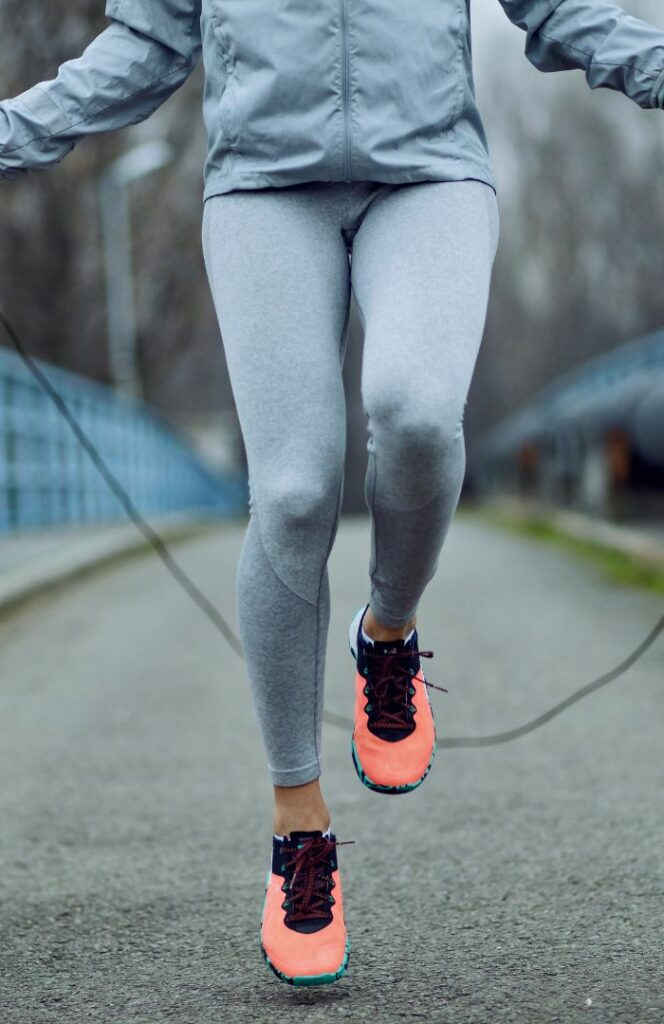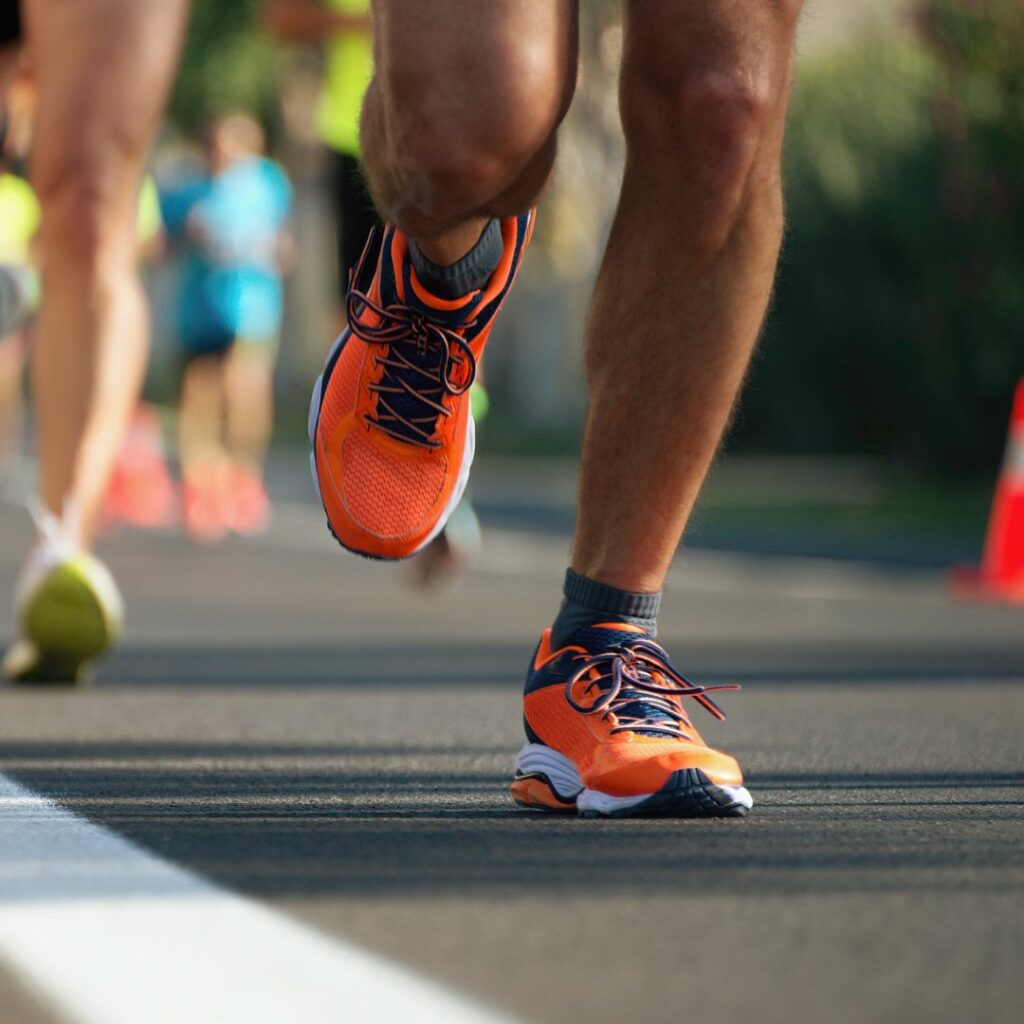This article is the first in a series on injury prevention with exercise. In this first installment, Dr. Bryce Lee, DPT, explains what causes overuse injuries, and which activities are most likely to be involved.

Imagine this. You just watched a video about jumping rope for exercise. It seems intense, and you loved to do it as a kid. You’ve been meaning to get more active, but don’t like running. Luckily, jumping rope works similar muscles to running, and gets you breathing hard! So you get a rope and get to work.
Because you’ve jumped rope in the past, your body remembers it like riding a bike. In just a few days, you are skipping rope for up to 3-4 minutes at a time, and in two weeks, you are accumulating hundreds, or even thousands of skips a day. You’re loving the fact that you can get winded and feel your muscles burn without having to leave your garage.
But then your heel starts bugging you. You think: “Maybe I bumped it against something, or stepped on a Lego.” You ignore what feels like a minor irritation, and don’t associate it with your new rope-jumping regimen. In fact, your heel even feels a little better after a minute of rope-jumping. Surely the exercise has nothing to do with the problem. Right?
Fast-forward another week or two, and now you are limping in your first steps each morning. The pain may subside a bit, but there is still some discomfort as you walk throughout the day. NSAIDS like ibuprofen help, but you’re getting really frustrated because now you can’t even enjoy walking, let alone skipping rope.
What went wrong? Jumping rope felt totally manageable. You weren’t even killing yourself on your workouts. And yet now it feels obvious that this new activity has left you with an overuse injury of your foot. How did this happen?
What are overuse injuries?
Bones can suffer stress injuries and stress fractures.

Overuse injuries happen when our connective tissues are stressed repeatedly and excessively, so that they can’t recover and be repaired between bouts of stress. The most commonly injured tissues are our bones, and our tendons, which attach our muscles to our bones.
When you load your bones in a new way, and give them adequate recovery, they builds back stronger than before. But when we chronically overstress them, they can develop what are called stress injuries. This is where an area of the bone starts to deteriorate due to the excessive stress and inadequate recovery. If the stresses continue, it can progress to a stress fracture, where a very fine crack develops in the bone. This crack can be so fine that X-rays won’t find it, necessitating a CT or MRI.

Tendons get tendinopathies (aka tendinitis/osis)
With a tendon, the same pattern of over-stress and under-recovery leads to deterioration of the tendon. Initially, over-stress might cause a “tendinitis,” or simple inflammation of the tendon. But as the problem continues, and the tendon starts to degenerate from the persistent loads and inadequate recovery.
Once the pain becomes chronic, the condition progresses to a tendinopathy. The collagen becomes disorganized in the tendon, and it becomes intolerant of loading. People with elbow tendinopathy can feel pain with even light gripping activities. Similarly, tendinitis of the muscles that give the foot its arch can even find walking to be painfully limited.
What causes overuse injuries?
This article is not about treating overuse injuries. If any painful musculoskeletal issue becomes chronic and affects your daily life, you should consult with your orthopedist or physical therapist for the best guidance on how to manage it. Once present, tendinopathies and bony stress injuries can take a while to heal. If they are in the leg or foot, a special boot may be needed to completely de-load the tissues.
The good news is that most overuse injuries, even stress fractures, tend to fully resolve in time with proper management. But before we worry about recovery, we should discuss what causes overuse injuries, so we can learn how to prevent them!
Risk factor 1: High Forces
Tissues like bones and tendons are stressed most by high forces.
Let’s dust off something from high school physics:
Force = Mass X Acceleration.
Acceleration means a change in velocity. Imagine that your body weight is moving down in a squat, and you quickly reverse direction to stand back up. This represents a massive change velocity, much greater than simply holding still and resisting the earth’s gravitation acceleration with a wall-sit.
Another, even geekier way to understand the effect that speed has on your tissues is with the formula for Kinetic Energy.
Kinetic Energy = 1/2 Mass X Velocity2
That’s right. The velocity get’s squared in calculating kinetic energy. So if you double the speed of a movement, you quadruple it’s kinetic energy! That’s why you yank on a piece of dental floss to break it, instead of gradually pulling on it.
Let me say that again: Doubling speed quadruples risk. Similarly, slowing down massively reduces risk.
Activities that involve speed necessarily involve high forces. So it’s no surprise that running, skipping rope, or playing tennis all are common ways to cause overuse injuries. The sudden, repetitive, high speed impact nature of the activity means lots of strain on connective tissues. Now, this does not mean you shouldn’t enjoy these activities! It just means we want to ease into them, knowing that too much, too soon of a new thing could cause problems.
Risk Factor 2: High repetition with low fatigue.
This one sounds counter-intuitive, but it’s hard to get tendonitis from an activity that quickly exhausts your muscles. Think of a wall-sit. In just a few minutes, your quadriceps may be quivering and burning. And because of that, the activity is very self-limiting. It’s hard to overdose on wall-sits because your muscles call it quits pretty early.

With our tendons and bones, however, we don’t get the same immediate feedback. Our tendons don’t burn and ache when they are tired or over-stressed. And this fact is actually part of the reason our bodies can be so efficient. Our tendons can act like springs, storing energy as we land and then releasing that energy as we push off, like a pogo stick. That’s why Usain Bolt has a short calf muscle but a huge calf tendon! You see, any movement we get by squeezing our muscles costs us energy (calories). But movement that we get from our tendons is “free,” in that it doesn’t cost as many calories. It is this very feature of efficiency that causes our bodies to try and use our tendons as springs whenever possible.
And since we can’t feel our tendons getting tired, it is very easy to over-stress them in a repetitive activity. Even if we are feeling systemically tired, the tendons in our ankles (running/jumping rope) or elbows (tennis) may not feel tired. And if we come back to the activity without adequate recovery, our tendons may not feel sore the way a muscle would.
That’s the key take-away. Muscles are cry-babies that protest at the slightest fatigue. Tendons and bones, on the other hand, suffer in silence. They won’t tell you they are over-worked until it’s too late.
Risk Factor 3: Novelty
As we grow, develop, and live our lives, our bones and connective tissues are constantly reorganizing themselves to efficiently deal with the stresses placed upon them. Where there is stress, our bodies will build additional strength (if we give them adequate time). And if we take away a stress that used to be there, our body will down-size, just like a company, and get rid of any muscle, tendon thickness or bone density that isn’t deemed necessary. With bone, this is called Wolff’s Law, and it explains why sedentary living predisposes us to osteoporosis.
In addition to the amount of minerals or collagen in a tendon, there is also the question of those raw materials are organized. Two tendons might be the same size, but if they are stressed differently every day, they may have a different collagen or mineral structure to prepare them for the specific loads they deal with.
The take-away from all this nerdy stuff is simple: If you haven’t been doing a specific task, even if you are an avid exerciser, the likelihood is that your connective tissues simply aren’t prepared to handle that new activity. This goes even for things you used to do well, but haven’t done in many years. Now, this doesn’t mean you can’t enjoy your chosen sport or recreational activity! It just means you need to assume your body will require a substantial adaptation period before you can really do all you want to do.
Risk Factor 4: Your own health status.
If you ran cross-country races all through high school, it can be easy to think your body will get used running again in no time. But the reality is that a decade or two makes a significant difference in recovery. And on top of that, your last attempt to pick up the activity (such as rock climbing) might have come after you were already very active with other activities. But if you are trying to get back into that same activity now, after a decade of being mostly sedentary, than you can’t take your past experience as indicative of how your body will respond this time.
And it should go without saying that if you have other health issues that have developed, this will further affect recovery. A full discussion of osteoporosis, connective tissue disorders, or systemic inflammatory conditions is outside the scope of this article. No discussion of what causes overuse injuries is complete without understanding our own health status and recovery ability. Most of us simply need to ease into things a good deal slower than our first instinct would suggest.
To go a step further, a change in health status can also explain why an activity we have already been doing could cause an overuse injury. Activities involving wear and tear create a burden on our body’s ability to recover and repair. Any recent change in your health which may impair your overall recovery, such as elevated systemic inflammation, or a deficiency in bioavailable vitamins or protein, could erode your ability to recover from every day activities, and lead to an overuse problem.
I mention these last things simply to say that if some new ache or pain has recently developed, and you truly can’t tie it to any change in activity, the issue may actually be a systemic problem related to health or lifestyle factors. Difficulty sleeping, poor energy levels, or trouble managing your weight can all be signs that the entire system may be struggling to deal with lifestyle factors. We should look to addressing the root cause of these systemic health issues as part of our strategy to resolve unexplained aches and pains.
Conclusion
I wish I had been able to read this article in my 20’s. I’ve made all the mistakes I’ve described here, and if I’d known then what causes overuse injuries, I might have accomplished many things which injuries kept me from achieving. I hope you can learn from both my experience and expertise to avoid the same pitfalls
In the next article, we’ll dig into how you can take any activity and safely build up your capacity to enjoy it. Though everyone’s health situation is different, I want you to be optimistic about your ability to enjoy new physical activities, even if they have some of the above risk factors. Thanks for reading, and stay tuned for part 2!

